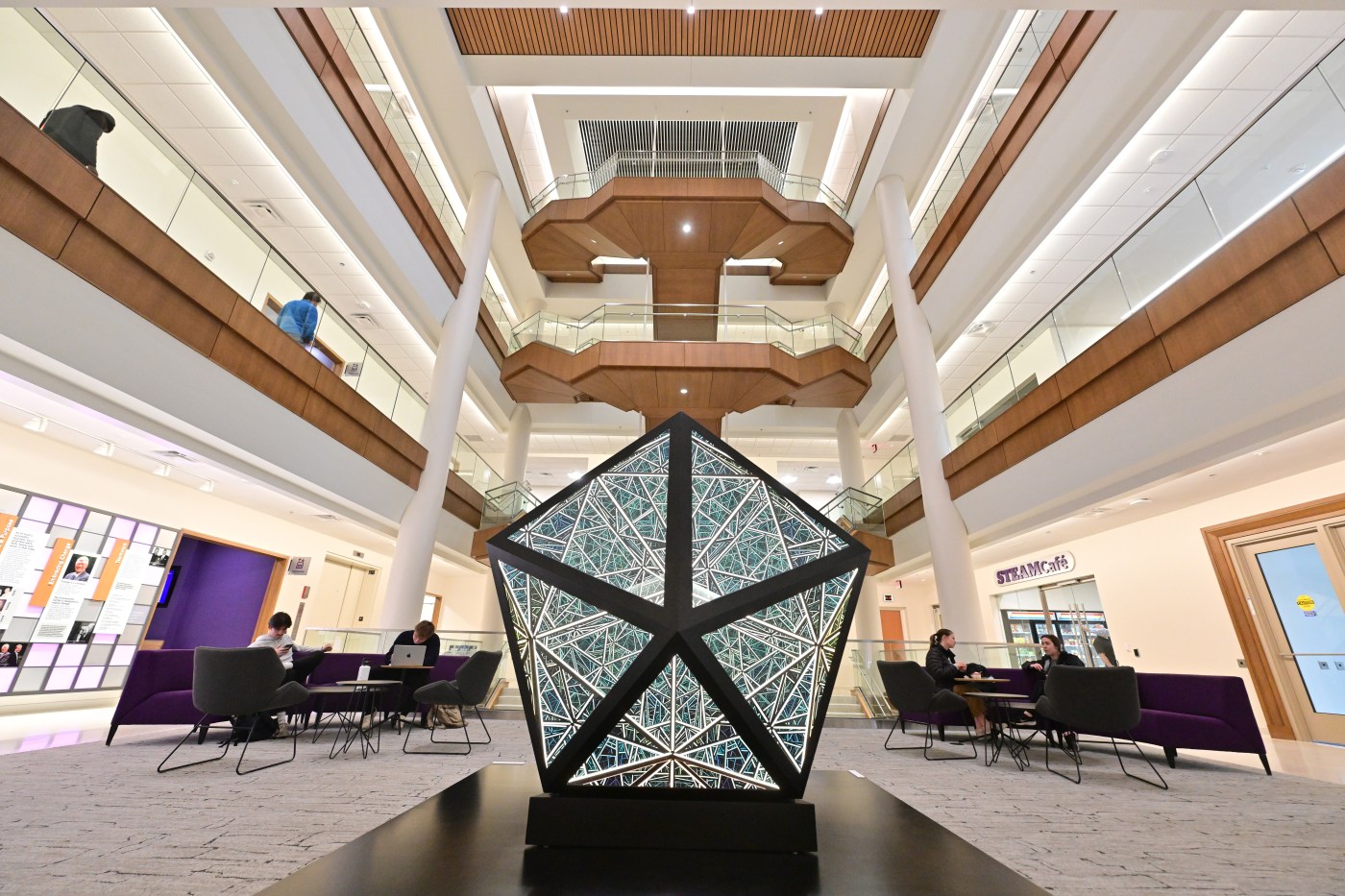
University of St. Thomas unveils $110 million, four-level ‘STEAM’ building with Shoenecker Center
A row of 3D printers in a 3D printing lab at the University of St. Thomas’ Shoenecker Center on Thursday, Feb. 8, 2024. (John Autey / Pioneer Press)
The large robotic arm, the multi-story concrete testing lab, the bank of 3D printers and roomy audio-visual broadcast editing suites that outfit the new Shoenecker Center at the University of St. Thomas aren’t just there for show.
But the visuals are still hard to miss, and that’s by design.
Glassy studio walls throughout the four-story, $110 million addition to the St. Paul campus aim to showcase the latest hands-on learning in the realm of STEAM, or science, technology, engineering, arts and math.
Students this month began exploring the long-awaited academic center that was built to seamlessly adjoin the O’Shaughnessy Science Hall toward the corner of Summit and Cretin avenues. With a heavy emphasis on engineering and collaborative space for interdisciplinary learning, the 130,000 square foot building provides new classroom and lab rooms for a wide range of scientific pursuits, including rehearsal areas and a sizable hall for musical performances. Yes, music is a kind of science.
The Grand Avenue entrance at the University of St. Thomas’ Shoenecker Center on Thursday, Feb. 8, 2024. (John Autey / Pioneer Press)
So is chemistry, biology, physics, engineering and the university’s Department of Earth, Environment and Society, which studies atmospherics and solid rock hand in hand with human behavior.
Civil engineers, computer engineers, mechanical engineers and electrical engineers all toil near “emerging media” multimedia editing rooms, including a new headquarters for ThreeSixty Journalism, a nonprofit that guides high school students into the world of journalism.
Students relax and study in the one of the commons area at the University of St. Thomas’ Shoenecker Center on Thursday, Feb. 8, 2024. (John Autey / Pioneer Press)
‘A mix of science, engineering and the arts’
A documentary filmmaker in the building is at work on a true-crime movie about the “Fishing Hat Bandit,” who robbed 23 Twin Cities banks in 18 months while wearing a fishing hat. Elsewhere, students are designing video games, and exploring the latest science around concrete.
“You have a mix of science, engineering and the arts, and that’s something that most universities don’t do,” said Bill Tolman, a trained chemist who serves as the dean of the school’s College of Arts and Sciences. “This is a unique way of delivering a liberal arts education. It is literally all thrown together.”
The Shoenecker Center’s programs have enrolled some 1,500 students this spring semester, though additional students will use the building for collaboration and research. Tolman pointed to the large programmable arm in the third-floor robotics lab, which will be used to showcase mechanical, electrical and computer engineering.
Little more than a glass wall separates the programmers of tomorrow from gawkers in the hallway who may be students of another discipline entirely, and that’s on purpose. Tolman said multiple interdisciplinary programs are in the works.
Charle Allhands, Civil Engineering Lab manager, talks about the new Civil Engineering Lab at at the University of St. Thomas’ Shoenecker Center on Thursday, Feb. 8, 2024. (John Autey / Pioneer Press)
Expansion of engineering program
The Shoenecker Center “was really hard to build, because it has all these different kinds of spaces. You have electrical and ventilation requirements (for labs), and then you have rehearsal space, which is completely different,” Tolman said. “There’s lots of glass. It’s like a giant fish bowl, and that’s by design, because that’s where creativity comes from.”
Deborah Besser, associate dean in the School of Engineering, said the center represents the first major physical expansion of the school’s engineering program in recent memory, even though the field has exploded in popularity. One in nine undergraduates at St. Thomas are enrolled in engineering, and the seven-year-old civil engineering program in particular — think public infrastructure like roads and bridges — was due for an upgrade to its equipment and facilities.
“We simply didn’t have enough space to teach the labs we had,” said Besser, a civil engineer by training, recalling how lab spaces would have to be converted on the fly for multiple disciplines. “We would roll equipment in and roll equipment out.”
The addition of the Shoenecker Center takes scheduling pressure off the old labs, which have been retained at the O’Shaughnessy Science Hall, the Facilities and Design Center and nearby Brady Hall, which still maintains music practice rooms and offices.
Just as importantly, said Besser, the new center moves students beyond thinking that engineering ends with math and science. There’s an opportunity “to integrate creativity in problem solving … solving problems for society and integrating ‘What is the best solution for the common good?’”
Workers set up the music hall at the University of St. Thomas’ Shoenecker Center on Thursday, Feb. 8, 2024. (John Autey / Pioneer Press)
The art of the Shoenecker Center
Creative reminders that little in science happens in a vacuum line each level of the center.
In “Portal Icosahedron,” a man-sized sculpture situated by the ground floor entrances, illuminated infinity mirrors create an endless labyrinth within a 20-sided structure assembled by the British-American artist Anthony James, who developed a similar piece for the movie “Knives Out: Glass Onion.”
The art, said Tolman, is in the shape of a pathogen.
“Many viruses are actually that shape,” he said. “It has a scientific basis, but it’s also very beautiful. … If you look inside, you can see forever.”
The piece was donated by John P. Monahan, whose dedicated art gallery within the Shoenecker Center opens Feb. 15.
Where else might art intersect engineering? In a pathogen, of all places. For at least a few years now, artistically-inclined microbiologists have been mixing microorganisms with jelly-like agar, a substance derived from seaweed, to create elaborate works of art in petri dishes, a discipline that finds workspace in one of the Shoenecker Center’s basement labs.
Two stream tables occupy part of instructor Tania Vislova’s Applied Geology class the University of St. Thomas’ Shoenecker Center on Thursday, Feb. 8, 2024. (John Autey / Pioneer Press)
Also showcased in the basement is a large twisted hunk of the Interstate 35E bridge, which collapsed into the Mississippi River in Minneapolis in 2007, killing 13 people and injuring 145 others when many of today’s students were still in their infancy. The cause of the collapse was blamed on undersized gusset plates, and a warped plate bent away from the thicker steal beam it’s supposed to rest on serves as a stark visual reminder of the importance of sound civil engineering.
The end user, after all, is people, and the goal of civil engineering — like the Shoenecker Center itself — is to partner with community and industry on real-world problems.
Site of Loras Hall
Outside the center, construction crews this month were leveling the earth to make room for a future basketball and hockey arena for up to 5,000 fans.
The school’s teams, which only recently entered Division 1, will compete in line of sight from broadcasting and engineering labs that also look out onto the Minneapolis skyline for one of the more formidable views on campus.
Construction of the Shoenecker Center at its particular location had been opposed by historic preservationists — including the city’s Heritage Preservation Commission, the Summit Avenue Residential Preservation Association and the Cass Gilbert Society — who objected to the demolition of Loras Hall, a former seminary dormitory designed by renowned St. Paul architect Cass Gilbert.
Electronic measuring equipment wait to be used by students in a lab at the University of St. Thomas’ Shoenecker Center on Thursday, Feb. 8, 2024. (John Autey / Pioneer Press)
Calling the 1890s-era building one of Gilbert’s less celebrated contributions to the city’s architectural history, the St. Paul City Council voted 6-1 in January 2021 to reverse the HPC decision that had blocked demolition.
Related Articles
Men’s basketball: North Dakota pays back St. Thomas with win on Tommies’ home court
Men’s basketball: St. Thomas rallies in second half to top North Dakota State
University of St. Thomas picks Notre Dame professor for law school dean
Men’s basketball: South Dakota State escapes St. Thomas’ snare with 1-point win
Opponents of University of St. Thomas sports arena at Cretin and Grand file legal appeal


